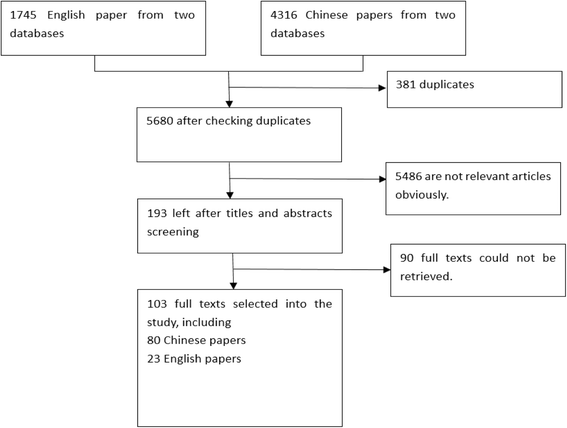Development of village doctors in China: financial compensation and health system support
- PMID: 28666444
- PMCID: PMC5493879
- DOI: 10.1186/s12939-016-0505-7
Development of village doctors in China: financial compensation and health system support
Abstract
Background: Since 1968, China has trained about 1.5 million barefoot doctors in a few years' time to provide basic health services to 0.8 billion rural population. China's Ministry of Health stopped using the term of barefoot doctor in 1985, and changed policy to develop village doctors. Since then, village doctors have kept on playing an irreplaceable role in China's rural health, even though the number of village doctors has fluctuated over the years and they face serious challenges. United Nations declared Sustainable Development Goals in 2015 to achieve universal health coverage by 2030. Under this context, development of Community Health workers (CHWs) has become an emerging policy priority in many resource-poor developing countries. China's experiences and lessons learnt in developing and maintaining village doctors may be useful for these developing countries.
Methods: This paper aims to synthesis lessons learnt from the Chinese CHW experiences. It summarizes China's experiences in exploring and using strategic partnership between the community and the formal health system to develop CHWs in the two stages, the barefoot doctor stage (1968 -1985) and the village doctor stage (1985-now). Chinese and English literature were searched from PubMed, CNKI and Wanfang. The information extracted from the selected articles were synthesized according to the four partnership strategies for communities and health system to support CHW development, namely 1) joint ownership and design of CHW programmes; 2) collaborative supervision and constructive feedback; 3) a balanced package of incentives, both financial and non-financial; and 4) a practical monitoring system incorporating data from the health system and community.
Results: The study found that the townships and villages provided an institutional basis for barefoot doctor policy, while the formal health system, including urban hospitals, county health schools, township health centers, and mobile medical teams provided training to the barefoot doctors. But After 1985, the formal health system played a more dominant role in the CHW system including both selection and training of village doctors. China applied various mechanisms to compensate village doctors in different stages. During 1960s and 1970s, the main income source of barefoot doctors was from their villages' collective economy. After 1985 when the rural collective economy collapsed and barefoot doctors were transformed to village doctors, they depended on user fees, especially from drug sale revenues. In the new century, especially after the new round of health system reform in 2009, government subsidy has become an increasing source of village doctors' income.
Conclusion: The barefoot doctor policy has played a significant role in providing basic human resources for health and basic health services to rural populations when rural area had great shortages of health resources. The key experiences for this great achievement are the intersection between the community and the formal health system, and sustained and stable financial compensation to the community health workers.
Keywords: Barefoot doctor; Community health worker; Compensation; Health system; Village doctor.
Figures
Similar articles
-
Transformation of health care in China.N Engl J Med. 1984 Apr 5;310(14):932-6. doi: 10.1056/nejm198404053101428. N Engl J Med. 1984. PMID: 6700690
-
How China's new health reform influences village doctors' income structure: evidence from a qualitative study in six counties in China.Hum Resour Health. 2015 May 5;13:26. doi: 10.1186/s12960-015-0019-1. Hum Resour Health. 2015. PMID: 25940189 Free PMC article.
-
Extending access to essential services against constraints: the three-tier health service delivery system in rural China (1949-1980).Int J Equity Health. 2017 May 23;16(1):49. doi: 10.1186/s12939-017-0541-y. Int J Equity Health. 2017. PMID: 28532500 Free PMC article.
-
Health care in China: a rural-urban comparison after the socioeconomic reforms.Bull World Health Organ. 1993;71(6):723-36. Bull World Health Organ. 1993. PMID: 8313490 Free PMC article. Review.
-
The Turning Point of China's Rural Public Health during the Cultural Revolution Period: Barefoot Doctors: A Narrative.Iran J Public Health. 2018 Jul;47(Suppl 1):1-8. Iran J Public Health. 2018. PMID: 30186806 Free PMC article. Review.
Cited by
-
The role of primary physician training in improving regional standardized management of diabetes: a pre-post intervention study.BMC Prim Care. 2022 Mar 21;23(1):51. doi: 10.1186/s12875-022-01663-5. BMC Prim Care. 2022. PMID: 35313820 Free PMC article.
-
Factors influencing work engagement among male nurses: A structural equation model.Nurs Open. 2023 Dec;10(12):7749-7758. doi: 10.1002/nop2.2016. Epub 2023 Oct 4. Nurs Open. 2023. PMID: 37794567 Free PMC article.
-
Chinese Hospitalized Cardiovascular Patients' Attitudes Towards Self-Management: A Qualitative Study.Patient Prefer Adherence. 2020 Feb 17;14:287-300. doi: 10.2147/PPA.S236348. eCollection 2020. Patient Prefer Adherence. 2020. PMID: 32109995 Free PMC article.
-
Analysis of patient medication compliance and quality of life of physician-pharmacist collaborative clinics for T2DM management in primary healthcare in China: A mixed-methods study.Front Pharmacol. 2023 Mar 24;14:1098207. doi: 10.3389/fphar.2023.1098207. eCollection 2023. Front Pharmacol. 2023. PMID: 37033638 Free PMC article.
-
Framing financial incentives to promote hypertension care among rural primary doctors in Shandong Province, China: study protocol of a randomized field trial.Health Econ Rev. 2025 Apr 21;15(1):36. doi: 10.1186/s13561-025-00634-7. Health Econ Rev. 2025. PMID: 40257512 Free PMC article.
References
-
- World Health Organization . Community health workers: pillars for health for all (report of the interregional conference, Yaoundé, Cameroon, 1-5 december 1986. Geneva: World Health Organization; 1987.
-
- World Health Organization . Strengthening the performance of community health workers in primary health care: report of a WHO Study Group. Geneva: World Health Organization; 1989. - PubMed
Publication types
MeSH terms
LinkOut - more resources
Full Text Sources
Other Literature Sources
Medical


